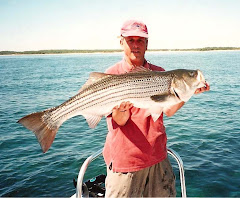
The temptation to head “east” was building within me since the week before last, reaching a zenith when I spoke with my good friend, Captain Adrian of Alpha Fishing Adventures about getting together to toss some flies around. We decided to head out to Montauk on Thursday, with the primary objective of exploring for hard tails…albies. As it turned out, Montauk didn’t disappoint and the rips delivered. The bluefish were easy, the bass required some coaxing and the false albacore made quite a showing, yet displayed a very high sense of feeding selectivity. At first, Captain Adrian and I cast various flies to busting little tunny and had many follows, swirls and subsequent rejections. We tried big flies and small flies and all of our personal favorites without so much as a touch. At one point I had tied on every one of my productive bonito and albie flies, to no avail - not one solid hook-up. There was plenty of interest in our patterns but no takers. We were getting quite frustrated by these fish. It was then that my angling partner reached into his fly box and pulled out a very diminutive pattern that he had yet to try. As it turned out, that fly reinforced the old adage that when fishing for albies, a fly’s size and color often does matter. While I have caught albies in the past on large silversides patterns and even large plugs, on this day they wanted none of that. They were keyed in on flies that precisely matched the size, profile and coloration of the real bait they were eating – bay anchovies.
The first retrieve of that newfound fly brought a solid strike and following a few superb runs, we tailed the icebreaker, a solid albie of about 7 or 8-pounds. I continued using a mid-sized hair fly until Adrian’s second cast brought another strong take. Several runs later we tailed the second consecutive albie on that fly. It was then that I decided to grub one of those flies from my buddy and give it a try. Adrian handed over his only other remaining fly of that design and I tied it on. Coming upon a fresh pod of fish my first cast with the day’s magic pattern resulted in an instantaneous hook-up. Adrian hooked up again as well. We were now onto something. We caught quite a few more albies using that fly and kept praying some errant bluefish wouldn’t hit it - the 20-pound fluorocarbon certainly would not withstand their teeth. Fortunately, for the balance of the day, we encountered only bass and albies.
The albies were present in very solid numbers. At times, there were so many sizeable pods of fish around us we didn’t know which ones to approach first. That is a nice fly fishing problem to have! I am just going to have to head back out there again soon to try for the ones we missed. The albies are sure to hang around for quite a while longer. If you’d like to know more about the specific pattern we used, just email me and I will respond.
I called Adrian (Alphafishing.com) on Saturday morning since he was back out at Montauk with a charter. As soon as he answered his cell phone, it was, “Hi Ang, Its AMAZING today! We have been surrounded by acres of busting striped bass and albies all morning. Gotta go, call you later. By the way, my arms are killing me!” Now how do you think I felt about that report sitting at home at my PC writing this blog entry? I was wishing I were there instead of typing at the keyboard. But the good news is this is only the beginning of some great fly-fishing at “The End”! Montauk should see a terrific fall run for fly anglers.












